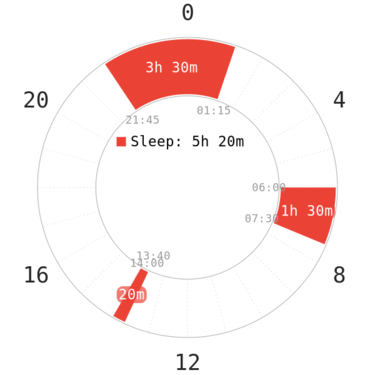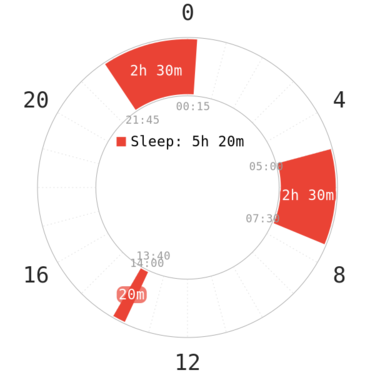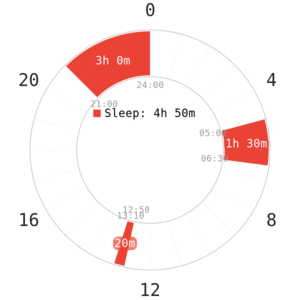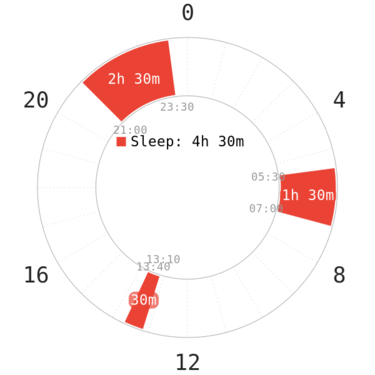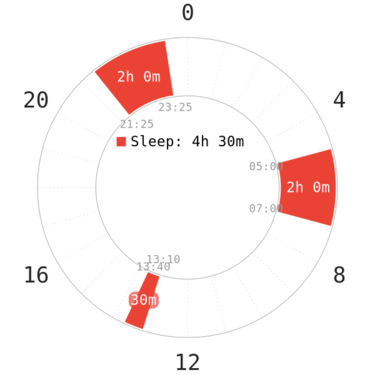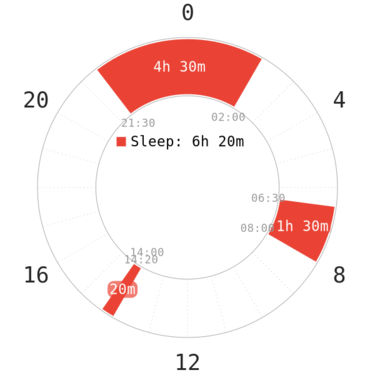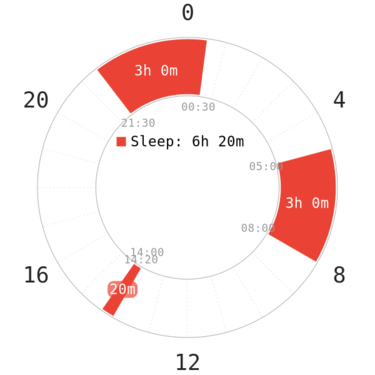DC1
| Dual Core 1 | |
|---|---|
| chart link
Legend
| |
| Total sleep | 5 hours 20 minutes |
| Proposed by | Polyphasic Society |
| Difficulty | Moderate |
| Specification | 2 core sleeps, 1 nap |
Dual Core 1, or DC1, is the first Dual Core schedule, which is the result of cutting some sleep from the second core of Segmented and the addition of one daytime nap to compensate.[1] DC1 is also considered a relatively easy schedule, and is often recommended to beginners.
Origin
DC1 was originally proposed by Polyphasic Society. Two variants are proposed, which are detailed in the Original variants section. The Discord community later slightly modified the schedule, to its current default form.
Mechanism
DC1's mechanism is similar to Segmented. Each core sleep is located around each respective sleep peak for efficiency. The first core is around the same length as the first core of Segmented, to preserve the amount of SWS, while the second core is cut short. This allows for sleep reduction on the schedule.
Currently the standard variant is recommended to have a core sleep of 3h20m and 1h40m respectively. The cycle length being a multiple of 100m instead of 90m is meant to accommodate either longer sleep cycles, or extra REM at the start or the end of the sleeps.
The nap is placed around the circadian dip in the early afternoon. However, the nap on DC1 is not always filled with REM sleep and may contain mostly NREM2 for some. Nevertheless, the nap helps sustain alertness until core 1.
DC1 is often compared to E2, as both schedules has sleeps placed at similar times of day. They have a similar amount of total sleep and the same number of sleep blocks (3) per day, with the main difference being E2 having a dawn nap rather than a dawn core on DC1.
Adaptation
Adaptation to DC1 is usually done cold turkey. Alternatively, it is also possible to adapt to this schedule gradually by first adapting to Segmented sleep.
Cold turkey
Since ~3h20m-3h30m core duration does not cover all SWS from the beginning, partitioning of SWS, which. High SWS requirements (at least ~150m) will likely require the extension of the first core (~4.5h instead) to cover all the SWS needs.
Gradual adaptation
This adaptation is likely slower than cold turkey, but the transition is designed to be less stressful from an adapted Segmented to a new DC1. However, there is no guaranteed success for DC1, and this method actually has seen lower success rate than the cold turkey method. This is largely due to the amount of time it would take to achieve good results on 2 successive adaptations.
However, for sleepers who have been adapted to Segmented and remain on it for a long time, the transition to DC1 at this point puts them on equal grounds with natural Segmented sleepers who are about to start a DC1 adaptation.
Difficulty
DC1 is a schedule of moderate difficulty. For naturally segmented sleepers, it is likely to be easier and more natural than E2. However, for others, E2 would be much easier, as it does not require SWS to be repartitioned. DC1 is known to be less flexible compared to E2, and as with all other Dual core schedules, it is much less tolerant to late cores.
Lifestyle Considerations
As with other Dual Core schedules, the first core sleep needs to be placed at earlier hours of the night to cover the SWS peak. Nighttime activities that force the first core to be delayed will cause damage to the schedule. While it is possible to recover from such events occasionally after adapting, it is very detrimental to adaptation, and may eventually cause the schedule to fall apart.
The longer night gap between the cores may also not be suitable for everyone, because staying awake for many hours at night everyday can be boring and eventually overwhelming.
Not many adapted DC1 (non-extended) sleepers have been able to flex the core sleeps by much. It would require lower sleep requirements overall, or experienced sleepers to be able to manage a flexible DC1. With the second core fixed, the first core may be moved up to 1 hour forward or back. It is uncertain as to how flexible the nap can be. Regardless, more data is required to determine how flexible DC1 can be, compared to E2, whose second nap is highly flexible in a lot of adapted people.
Having only a daytime nap, DC1 is suitable for jobs that allow a nap to be taken during a break.
With only a 2-cycle SWS core on the default variant, it may not fully accommodate the extra SWS need from intense exercise.
Variants
DC1 offers a several scheduling options. However, the only significantly successful variants are the original ones and the extended variant.
Original variants
These are the schedule variants originally proposed by Polyphasic Society. Both of these give a total of 5h in core sleep. The first variant has the same core 1 as Segmented, and may allow for a smoother transition from it. It closely resembles the current default version, and most of what is said about the standard one also applies to it.
The second one is more balanced in terms SWS and REM peak, and may allow for a more complete repartitioning. However, 2.5-hour cores increase the likelihood for SWS wakes. This increases the chance for oversleeping, especially in the first core. For some, waking up from SWS and/or REM is extremely challenging and best avoided. This variant may be better for those needing more REM than SWS.
Adapting to this variant may eventually result in 4 sleep cycles of ~75 minutes. However, this is mostly hypothetical and requires more data to confirm.
Slightly modified core durations
This variant relies on a slightly longer second core to account for a higher REM need. The higher total sleep also increases the chance for flexing either cores to greater effects. However, the 2.5-hour core may result in unpleasant wakes during adaptation. This
This one is more difficult than the standard one, as it has less total sleep time. Repartitioning of sleep stages will need to be more intense than on the standard version. This may be suitable for those with slightly lower monophasic needs (~7h). It is unknown how flexible the variant would be after adapting, since there are no records of its flexibility, and the successful cases did not continue to maintain the schedule or attempt to make it flexible after a couple months on it.
30m nap
These variants are derived from Triphasic, and has significantly less total sleep than standard DC1. They extend the night and morning cores, while shortening the daytime core of Triphasic to a 30m nap for ease of scheduling. Because there are 2 cores and 1 nap. Both attempts and adaptations have been rare, possibly because of the uncommon core lengths leading to difficult wakes. These two variants are likely to be much more difficult than standard DC1, perhaps similar to Triphasic in difficulty.
Long morning wake gap
The idea was originally posited by Polyphasic Society, where the heavy concentration of both cores at night resembles E1 or some sort of Biphasic schedule. The wake gap between 2 cores decreases to 4h, while there is an 8h wake gap between the second core and the nap. The promised utility from this setup is that it has a better chance to work from morning to afternoon hours without the possibility to have a nap around noon or during work. However, this has been very difficult, and has essentially zero successful adaptation because of the long morning gap. Individuals with lower sleep requirement can take advantage of this variant, because they usually can stay awake longer with a more distant sleep distribution, than an average person would.
This is a common ground in scheduling with E2 as well, with the morning gap between both naps usually no longer than ~6h to ensure no excessive tiredness during the whole wake gap to be adaptable. The afternoon wake gap on DC1 and E2 (from the last nap of the day to the core) is usually tolerable even if they appear to be longer than the recommended length. Since it is deemed easier to stay awake during the day, up to 9h wake is viable for the afternoon gap (for average individuals).
Siesta-alike
It is uncertain what the advantages of this scheduling would be compared to the traditional setup, where the second core is placed at hours that are virtually safe from any real life interruptions. However, some individuals do claim that a short nap around sunrise hours would give more chance for vivid dream recall than a core sleep, probably because of a higher percentage of REM sleep in a nap than in a core, and the period of REM that ends before awakening is likely shorter on a nap than on a core. Only one person has reportedly succeeded at adapting to this variant. The daytime core looks like that on Siesta, but it is questionable how it can be managed long-term, while a daytime nap is a lot more convenient to schedule.
Extended Variants
Both of these variants over the years have reported a lot of success (although more for the 4.5-1.5 core distribution). They are very beginner-friendly and offer a reasonable amount of sleep reduction (~90m of sleep cut from an 8h monophasic baseline). Those with a higher monophasic baseline (~9h) are also recommended to pick either variant. The choice between either variants comes down to REM and SWS requirements. A higher REM requirement would favor the 3-3 core combination, while a person with high SWS needs or exercise a lot for muscle growth can pick the 4.5-1.5 variant. Both variants also have an advantage that the regular version oftentimes does not, is the ability to have a somewhat later first core sleep, to start around ~11 PM rather than 9 or 10 PM on the default version.
Another benefit that either variant can afford is the ability to have a long morning wake gap, up to ~8h before the nap is taken because of a higher total sleep. Wakefulness sustaining is expected to be a lot easier than on a regular DC1 variant. This could allow one to stay awake through work, and then have a nap after work (~4-5 PM). There are also a lot of flexibility potential after the adaptation to this variant. One can choose to proceed to DC2, or simply learn to make the extended version flexible to adapt to DUCAMAYL.
References
- ↑ Polyphasic Society (2019). Dual Core Sleep. Retrieved 18-12-2020.
